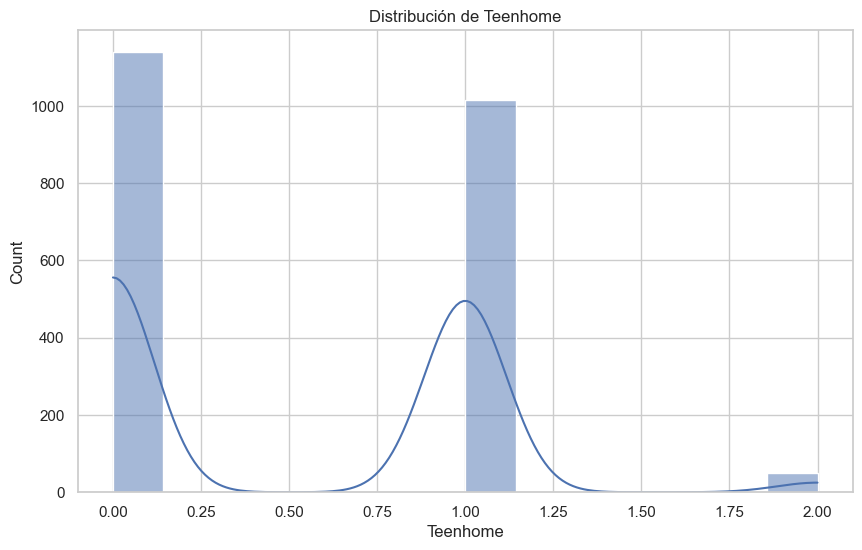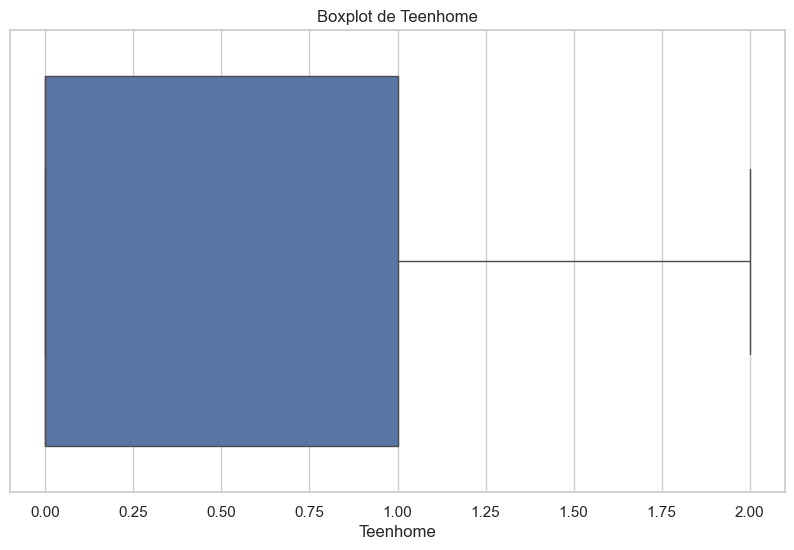Trabajemos en algunos gráficos#
Usaremos el datased ifood para evaluar la eficiencia de unas campañas publicitarias aplicadas en un restaurante.
Carga de datos#
Para cargar los datos debe hacer clic en el panel izquierdo en el botón de exploración de archivos. En ese menu tendra la opción de subir algunos datos.
import pandas as pd
# Load the dataset from the user's Google Drive
df = pd.read_csv("ifood_df.csv")
# Show DataFrame
df.head(5)
| Income | Kidhome | Teenhome | Recency | MntWines | MntFruits | MntMeatProducts | MntFishProducts | MntSweetProducts | MntGoldProds | ... | marital_Together | marital_Widow | education_2n Cycle | education_Basic | education_Graduation | education_Master | education_PhD | MntTotal | MntRegularProds | AcceptedCmpOverall | |
|---|---|---|---|---|---|---|---|---|---|---|---|---|---|---|---|---|---|---|---|---|---|
| 0 | 58138.0 | 0 | 0 | 58 | 635 | 88 | 546 | 172 | 88 | 88 | ... | 0 | 0 | 0 | 0 | 1 | 0 | 0 | 1529 | 1441 | 0 |
| 1 | 46344.0 | 1 | 1 | 38 | 11 | 1 | 6 | 2 | 1 | 6 | ... | 0 | 0 | 0 | 0 | 1 | 0 | 0 | 21 | 15 | 0 |
| 2 | 71613.0 | 0 | 0 | 26 | 426 | 49 | 127 | 111 | 21 | 42 | ... | 1 | 0 | 0 | 0 | 1 | 0 | 0 | 734 | 692 | 0 |
| 3 | 26646.0 | 1 | 0 | 26 | 11 | 4 | 20 | 10 | 3 | 5 | ... | 1 | 0 | 0 | 0 | 1 | 0 | 0 | 48 | 43 | 0 |
| 4 | 58293.0 | 1 | 0 | 94 | 173 | 43 | 118 | 46 | 27 | 15 | ... | 0 | 0 | 0 | 0 | 0 | 0 | 1 | 407 | 392 | 0 |
5 rows × 39 columns
Exploración de datos#
Vamos a explorar los datos para entender su estructura y contenido.
# Ayudame a ver las filas de la 20 a la 30 de df
df.iloc[20:31]
| Income | Kidhome | Teenhome | Recency | MntWines | MntFruits | MntMeatProducts | MntFishProducts | MntSweetProducts | MntGoldProds | ... | marital_Together | marital_Widow | education_2n Cycle | education_Basic | education_Graduation | education_Master | education_PhD | MntTotal | MntRegularProds | AcceptedCmpOverall | |
|---|---|---|---|---|---|---|---|---|---|---|---|---|---|---|---|---|---|---|---|---|---|
| 20 | 2447.0 | 1 | 0 | 42 | 1 | 1 | 1725 | 1 | 1 | 1 | ... | 0 | 0 | 0 | 0 | 1 | 0 | 0 | 1729 | 1728 | 0 |
| 21 | 58607.0 | 0 | 1 | 63 | 867 | 0 | 86 | 0 | 0 | 19 | ... | 0 | 0 | 0 | 0 | 0 | 0 | 1 | 953 | 934 | 1 |
| 22 | 65324.0 | 0 | 1 | 0 | 384 | 0 | 102 | 21 | 32 | 5 | ... | 0 | 0 | 0 | 0 | 0 | 0 | 1 | 539 | 534 | 0 |
| 23 | 40689.0 | 0 | 1 | 69 | 270 | 3 | 27 | 39 | 6 | 99 | ... | 1 | 0 | 0 | 0 | 1 | 0 | 0 | 345 | 246 | 0 |
| 24 | 18589.0 | 0 | 0 | 89 | 6 | 4 | 25 | 15 | 12 | 13 | ... | 0 | 0 | 0 | 0 | 1 | 0 | 0 | 62 | 49 | 0 |
| 25 | 53359.0 | 1 | 1 | 4 | 173 | 4 | 30 | 3 | 6 | 41 | ... | 0 | 0 | 0 | 0 | 1 | 0 | 0 | 216 | 175 | 0 |
| 26 | 38360.0 | 1 | 0 | 26 | 36 | 2 | 42 | 20 | 21 | 10 | ... | 0 | 0 | 0 | 0 | 1 | 0 | 0 | 121 | 111 | 0 |
| 27 | 84618.0 | 0 | 0 | 96 | 684 | 100 | 801 | 21 | 66 | 0 | ... | 0 | 0 | 0 | 0 | 0 | 0 | 1 | 1672 | 1672 | 1 |
| 28 | 10979.0 | 0 | 0 | 34 | 8 | 4 | 10 | 2 | 2 | 4 | ... | 0 | 0 | 0 | 0 | 0 | 1 | 0 | 26 | 22 | 0 |
| 29 | 38620.0 | 0 | 0 | 56 | 112 | 17 | 44 | 34 | 22 | 89 | ... | 1 | 0 | 0 | 0 | 0 | 1 | 0 | 229 | 140 | 0 |
| 30 | 40548.0 | 0 | 1 | 31 | 110 | 0 | 5 | 2 | 0 | 3 | ... | 1 | 0 | 0 | 0 | 1 | 0 | 0 | 117 | 114 | 1 |
11 rows × 39 columns
Hagamos una descripicón de los datos interesnates, en este caso, la descripción de las columnas: Income, Recency, Kidhome y Teenhome.
columnas = ['Income','Recency','Kidhome','Teenhome']
# Veamos información de las columnas seleccionadas
df[columnas].describe()
| Income | Recency | Kidhome | Teenhome | |
|---|---|---|---|---|
| count | 2205.000000 | 2205.000000 | 2205.000000 | 2205.000000 |
| mean | 51622.094785 | 49.009070 | 0.442177 | 0.506576 |
| std | 20713.063826 | 28.932111 | 0.537132 | 0.544380 |
| min | 1730.000000 | 0.000000 | 0.000000 | 0.000000 |
| 25% | 35196.000000 | 24.000000 | 0.000000 | 0.000000 |
| 50% | 51287.000000 | 49.000000 | 0.000000 | 0.000000 |
| 75% | 68281.000000 | 74.000000 | 1.000000 | 1.000000 |
| max | 113734.000000 | 99.000000 | 2.000000 | 2.000000 |
Gráficos de distribución#
Sabemos por nuestros cursos de estadística que los histogramas son una buena forma de entender la distribución de los datos. Hagamos un histograma para cada una de las variables mencionadas.
Income:
import pandas as pd
import matplotlib.pyplot as plt
import seaborn as sns
# Descripción de la variable 'Income'
print(df['Income'].describe())
# Histograma de la variable 'Income'
plt.figure(figsize=(10, 6))
sns.histplot(df['Income'], kde=True)
plt.title('Distribución de Income')
plt.show()
# Boxplot de la variable 'Income'
plt.figure(figsize=(10, 6))
sns.boxplot(x=df['Income'])
plt.title('Boxplot de Income')
plt.show()
count 2205.000000
mean 51622.094785
std 20713.063826
min 1730.000000
25% 35196.000000
50% 51287.000000
75% 68281.000000
max 113734.000000
Name: Income, dtype: float64
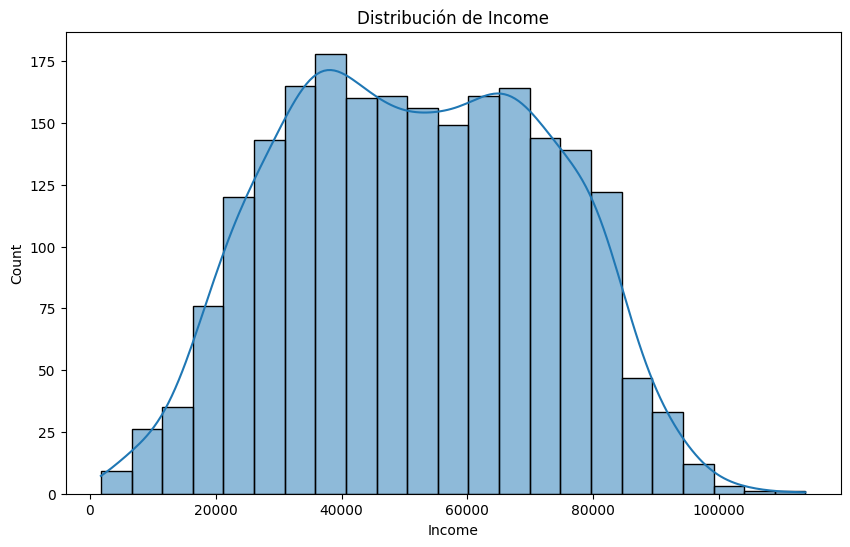
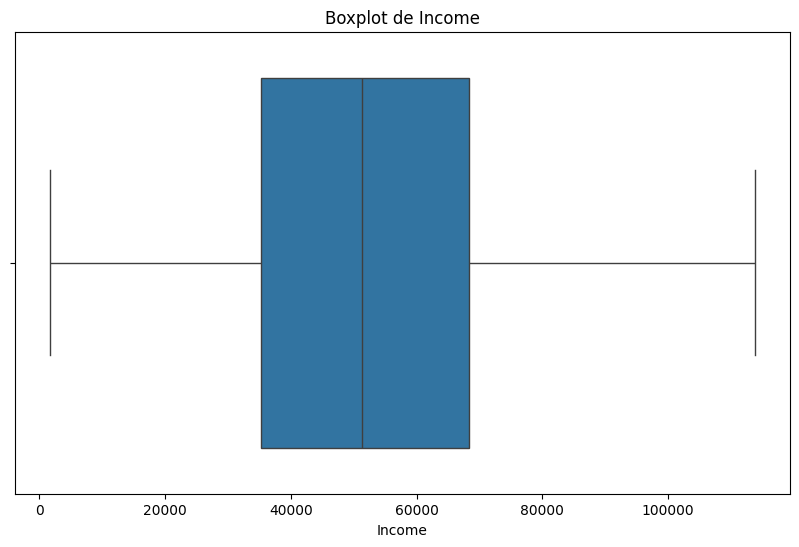
Recency:
## Describe la variable 'Recency'
print(df['Recency'].describe())
# Histograma de la variable 'Recency'
plt.figure(figsize=(10, 6))
sns.histplot(df['Recency'], kde=True)
plt.title('Distribución de Recency')
plt.show()
# Boxplot de la variable 'Recency'
plt.figure(figsize=(10, 6))
sns.boxplot(x=df['Recency'])
plt.title('Boxplot de Recency')
plt.show()
count 2205.000000
mean 49.009070
std 28.932111
min 0.000000
25% 24.000000
50% 49.000000
75% 74.000000
max 99.000000
Name: Recency, dtype: float64
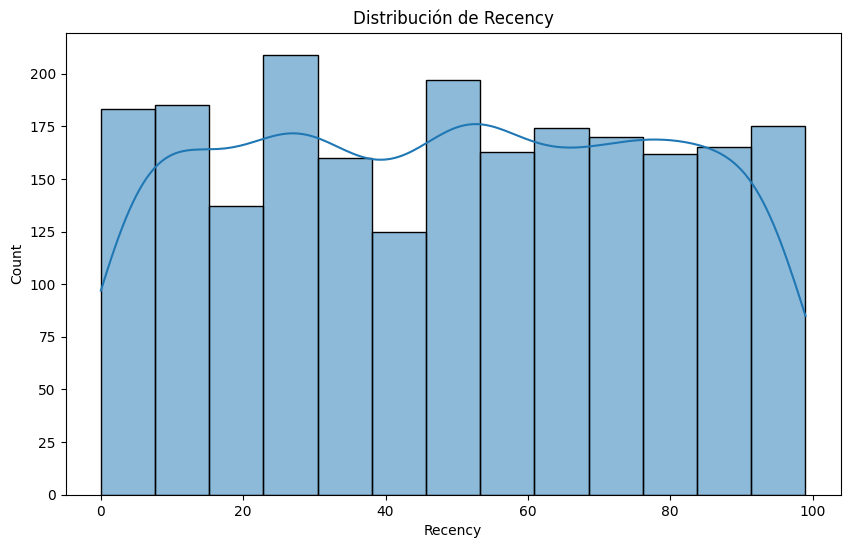
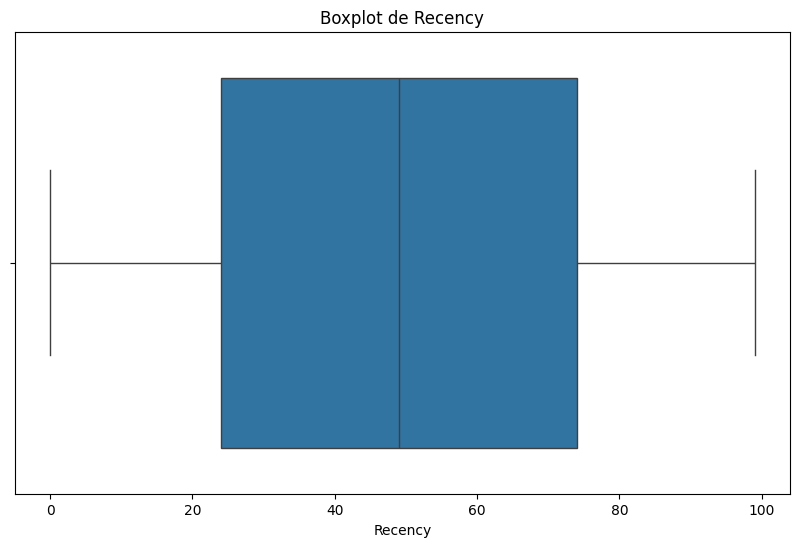
Note
Observe que la sintáxis para hacer un histograma es la siguiente:
import matplotlib.pyplot as plt
plt.hist(dataframe['columna'], bins=30)
plt.show()
La columna Recency se puede cambiar por cualquier otra columna que se desee analizar.
import seaborn as sns
sns.set_theme(style="whitegrid")
penguins = sns.load_dataset("penguins")
penguins
| species | island | bill_length_mm | bill_depth_mm | flipper_length_mm | body_mass_g | sex | |
|---|---|---|---|---|---|---|---|
| 0 | Adelie | Torgersen | 39.1 | 18.7 | 181.0 | 3750.0 | Male |
| 1 | Adelie | Torgersen | 39.5 | 17.4 | 186.0 | 3800.0 | Female |
| 2 | Adelie | Torgersen | 40.3 | 18.0 | 195.0 | 3250.0 | Female |
| 3 | Adelie | Torgersen | NaN | NaN | NaN | NaN | NaN |
| 4 | Adelie | Torgersen | 36.7 | 19.3 | 193.0 | 3450.0 | Female |
| ... | ... | ... | ... | ... | ... | ... | ... |
| 339 | Gentoo | Biscoe | NaN | NaN | NaN | NaN | NaN |
| 340 | Gentoo | Biscoe | 46.8 | 14.3 | 215.0 | 4850.0 | Female |
| 341 | Gentoo | Biscoe | 50.4 | 15.7 | 222.0 | 5750.0 | Male |
| 342 | Gentoo | Biscoe | 45.2 | 14.8 | 212.0 | 5200.0 | Female |
| 343 | Gentoo | Biscoe | 49.9 | 16.1 | 213.0 | 5400.0 | Male |
344 rows × 7 columns
df['Kidhome'].value_counts()
Kidhome
0 1276
1 883
2 46
Name: count, dtype: int64
## Describe la variable 'Kidhome'
print(df['Kidhome'].describe())
# Histograma de la variable 'Kidhome'
plt.figure(figsize=(10, 6))
sns.catplot(df['Kidhome'].value_counts(),kind="bar")
plt.title('Distribución de Kidhome')
plt.show()
count 2205.000000
mean 0.442177
std 0.537132
min 0.000000
25% 0.000000
50% 0.000000
75% 1.000000
max 2.000000
Name: Kidhome, dtype: float64
<Figure size 1000x600 with 0 Axes>
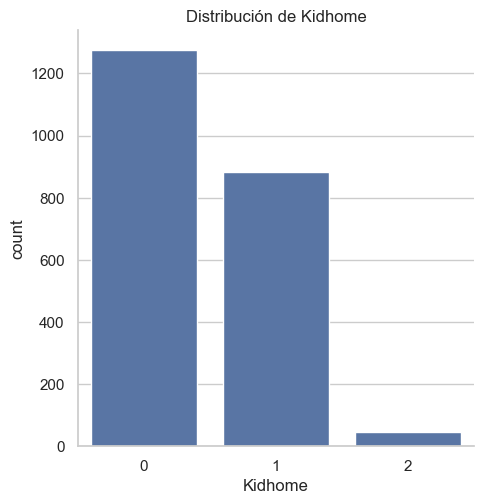
Kidhome:
## Describe la variable 'Kidhome'
print(df['Kidhome'].describe())
# Histograma de la variable 'Kidhome'
plt.figure(figsize=(10, 6))
sns.histplot(df['Kidhome'], kde=True)
plt.title('Distribución de Kidhome')
plt.show()
# Boxplot de la variable 'Kidhome'
plt.figure(figsize=(10, 6))
sns.boxplot(x=df['Kidhome'])
plt.title('Boxplot de Kidhome')
count 2205.000000
mean 0.442177
std 0.537132
min 0.000000
25% 0.000000
50% 0.000000
75% 1.000000
max 2.000000
Name: Kidhome, dtype: float64
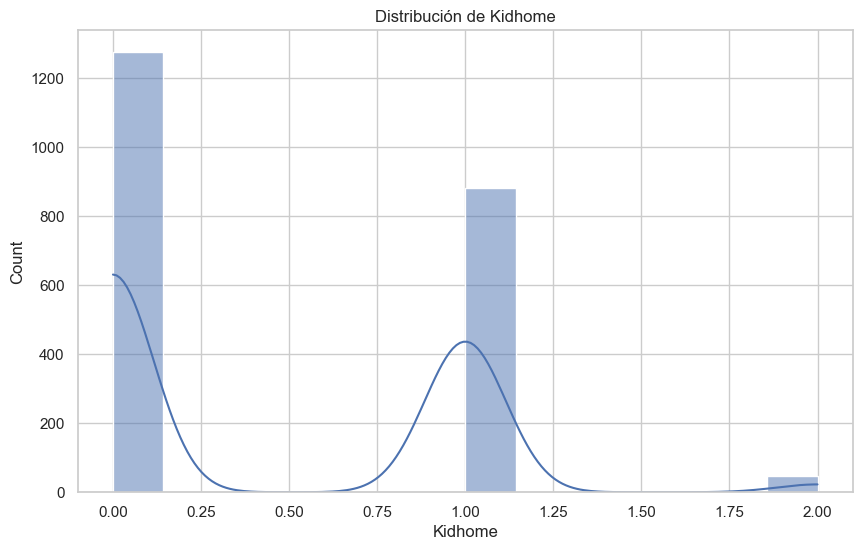
Text(0.5, 1.0, 'Boxplot de Kidhome')
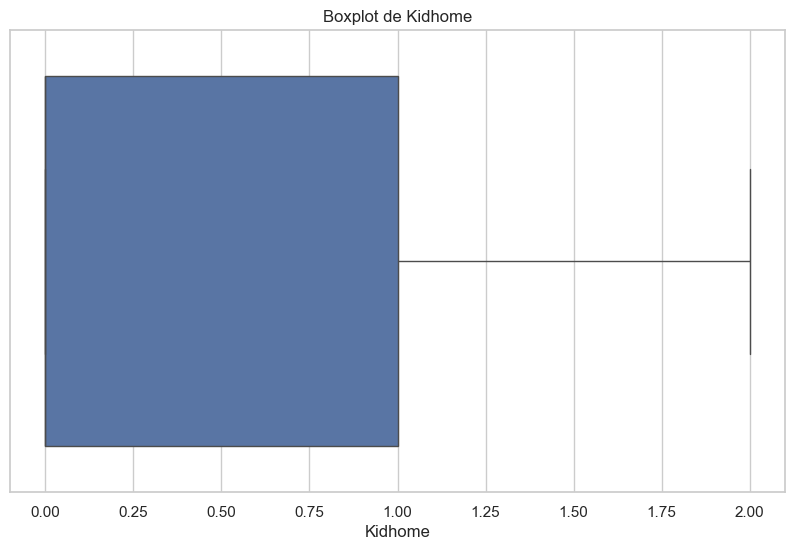
Teenhome:
## Describe la variable 'Teenhome'
print(df['Teenhome'].describe())
# Histograma de la variable 'Teenhome'
plt.figure(figsize=(10, 6))
sns.histplot(df['Teenhome'], kde=True)
plt.title('Distribución de Teenhome')
plt.show()
# Boxplot de la variable 'Teenhome'
plt.figure(figsize=(10, 6))
sns.boxplot(x=df['Teenhome'])
plt.title('Boxplot de Teenhome')
plt.show()
count 2205.000000
mean 0.506576
std 0.544380
min 0.000000
25% 0.000000
50% 0.000000
75% 1.000000
max 2.000000
Name: Teenhome, dtype: float64
